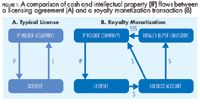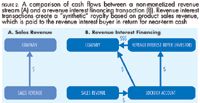Stream Power
Convert future revenue into present value with alternative approaches to access capital.
Healthcare product companies have intensive capital requirements. While this has historically been a challenge for small and mid-sized pharmaceutical and biotech companies, the current chaos in the financial markets poses a significant barrier to the growth and viability even of larger companies. Now more than ever, pharma companies need to consider alternative approaches to accessing the capital they need to grow and thrive.
For many pharma and biotech companies, one particularly attractive alternative is the sale of future revenue—either in the form of royalties or product revenue. Such sales, known as royalty monetization and revenue interest transactions, provide flexible alternatives to standard equity and debt financing, and can be customized to meet a company's near-term financial needs, as well as long term growth objectives, corporate priorities, and time lines. By converting future revenue into present value, these transactions provide capital today that can be invested in achieving tomorrow's growth potential.

While royalty monetization and revenue interest financing have long been available, they have become increasingly popular in the past few years. Deal flow, which historically was measured in the low hundreds of millions of dollars annually, now exceeds $1.5 billion.
What was once a unique way for small companies to raise $20 million to $50 million has now been adopted by progressively larger entities with greater capital requirements. It is clear from the increasing number and size of these transactions that they will be part of healthcare companies' capital formation strategies for the foreseeable future. No longer a stopgap measure to be used in chaotic markets, royalty monetization and revenue interest financing have become viable strategies for balancing near-term financial needs with long term growth objectives.
The Value of Future Revenue
The growth of the market for product revenue financing reflects the numerous potential benefits these transactions offer to small and medium-sized pharmaceutical companies seeking capital to achieve a variety of strategic objectives. These vehicles can benefit almost every company at some stage of the corporate life cycle, and in today's market conditions they are useful to a growing number of companies. Royalty monetization and revenue interest financing transactions are typically less expensive than traditional public or private equity. Additionally, because they do not involve equity, they do not dilute the ownership stake of a company's existing investors.
Royalty monetization and revenue interest financing transactions can be used to achieve a variety of strategic objectives. To date, their use in the pharmaceutical industry has included:
» Defraying the cost and risk associated with launching new products
» Increasing the amount of capital available for near-term R&D initiatives
» Strengthening a balance sheet through monetization of a passive royalty
» Resolving potential Federal Trade Commission (FTC) issues associated with the acquisition of companies with competing products
Royalty monetization and revenue interest financing are quite similar: In both cases, the company receives near-term cash in exchange for all or a portion of a future income stream. There are, however, some differences in the structure of deals and the flow of cash.
Royalty monetization converts a future income stream generated by an intellectual property asset or licensing deal into cash today. This reduces risk by shifting future revenue streams to the investor and allowing for greater "predictability" of cash flows to the company. In a royalty monetization transaction, a company sells all or a portion of a royalty stream in exchange for agreed-upon payments. Royalty payments that would typically flow to the company may be placed in a "lock box" account, with the agreed-upon portion of those payments flowing to the investor, and the remainder (if any) flowing back to the company. (See Figure 1.)

Figure 1: A comparison of cash and intellectual property (IP) flows between a licensing agreement (A) and a royalty monetization transaction (B)
Revenue interest financing converts all or a portion of an existing or future income stream from revenue on product sales into a significant source of up-front capital without impacting reported revenues or EBITDA. This provides an opportunity to use future cash flows to accomplish shorter term objectives and accelerate company growth. In this sort of transaction, a company in effect "borrows" funds and then uses revenues from product sales to "repay" the debt in the form of a synthetic royalty on sales to the investor. (See Figure 2.) The transaction may be also structured to include other financing elements such as equity and/or traditional debt.

Figure 2: A comparison of cash flows between a non-monetized revenue stream (A) and a revenue interest financing transaction (B). Revenue interest transactions create a "synthetic" royalty based on product sales revenue, which is paid to the revenue interest buyer in return for near-term cash
Royalty monetization and revenue interest financing transactions offer unparalleled flexibility and customization with respect to the interest being sold, the percentage of the interest sold, the territories covered by the agreement, and the duration of the agreement. Transactions can be structured to comprise royalty or revenue streams derived from a single product or a suite of products, and/or specific geographic territories. Similarly, a transaction can be a straight sale or a structured sale. For the latter, the structure can comprise a percentage and/or tier of royalty or revenue stream, and may include a cap on aggregate payments, either over the life of the transaction or annually, with surplus flowing to the seller. After the term of the agreement is completed, the entire revenue or royalty stream once again flows to the seller.
These transactions can be structured to enable companies to retain a large portion of the upside if the sales generating the royalty or revenue stream exceed expectations. Additionally, revenue interest transactions give a company the opportunity to repurchase revenue interest when additional capital becomes available, preserving long term value and growth potential.
The ability to tailor the duration of an agreement allows for consideration of near-term and long term corporate financing needs, as well as the potential of the product underlying the revenue stream and the changing condition of the financial markets. In today's financial environment, a transaction with an 18- to 24-month horizon provides shelter from the current stormy market conditions while providing maximum financing flexibility once the equity and debt markets become more favorable. In addition, the option for structures with longer time horizons provides companies with an important tool for managing future capital requirements.
This flexibility of structure, interest(s) sold, and length of the transaction enable pharmaceutical companies to meet their near-term capital needs while preserving substantial long term opportunities and growth potential.
Most significantly, the buyer in a product revenue financing transaction is more like a partner than an investor because there's a shared ambition for the success of the product underlying the revenue stream. Generally, the success of an individual product is predicated on the long term overall health of the company with product marketing responsibility. This provides the buyer with strong motivation to establish transaction terms that consider the various development and commercialization needs of specific products and companies on a case-by-case basis. Ultimately, alignment of the seller's and the buyer's objectives under these circumstances better supports long term corporate success than typical debt transactions do.
It's important to note, however, that the realization of these potential benefits is dependent on working with an investor who understands the risks and benefits inherent in developing and commercializing life sciences products. Companies should seek an investor with a level of expertise in the technology, development, manufacture, commercialization and product potential that is commensurate with their own. The growing number of successfully completed royalty monetization and revenue interest financing transactions should help companies identify qualified investors.
Case Studies in Customization
A number of recently completed royalty monetization and revenue interest financing transactions demonstrate the flexibility, utility, and diverse applications of these vehicles. The following case studies provide real-world perspective on the ways in which innovative companies throughout the pharmaceutical and biotechnology industries use these transactions to achieve a variety of strategic objectives.
Reducing the cost and risk of launching a new product Typically, pharmaceutical companies directly pay for contract services from contract development and commercialization organizations. However, a leading provider of these services has developed the capacity to offer a variety of risk-sharing deals. In a 2004 transaction with Eli Lilly & Co., a leading contract pharmaceutical development and commercialization company agreed to provide Lilly with five years of sales services in return for royalties on US net sales of Cymbalta (duloxetine), Lilly's antidepressant and pain reliever. The development and commercialization company also invested $110 million in marketing and milestone payments into the pre-approval Cymbalta program. The structure of the transaction allowed Lilly to establish new revenue streams without taking on the full cost or risk of launching a new product in multiple indications.
In this transaction, the contract development and commercialization company served as both the contract service provider and the royalty buyer. Similar transactions can be structured so that a third party provides all or a portion of the funding to the contract sales organization in return for sales royalties paid by the pharmaceutical company.
Offsetting R&D expenses Glenmark Pharmaceuticals (GPI), a wholly owned subsidiary of India-based Glenmark Pharmaceuticals, was looking to establish a portfolio of generic dermatology products for the US market in order to advance its niche products strategy into new indications and expand its offerings in the US generics space. The company sought non-dilutive access to capital to fund research and development for 16 dermatology products. GPI monetized a portion of the future revenues of these 16 products in return for $27 million, which was provided along with development milestones to match actual clinical development expenses. With this funding, GPI was able to offset its R&D expenses while building its US franchise.
Delaying a partnership to maximize value SkyePharma is a specialist drug delivery company that develops oral and inhaled therapies. The company needed $30 million to fund Phase III trials of its sustained-release morphine product DepoMorphine (now DepoDur). Although SkyePharma intended to find a commercialization partner, the company wanted to delay partnering until Phase III trials were complete in order to optimize its partnering economics.
The company entered into a hybrid monetization plan for a portion of its royalty/revenue interests on four of its products (three smaller products already on the market and DepoMorphine). SkyePharma estimated that delaying the partnership until after Phase III trials enabled the company to receive significant milestones and a higher royalty rate on sales of DepoMorphine than if the partnership had been established at the completion of Phase II trials.
Acquiring a new product Oscient Pharmaceuticals needed capital to acquire US rights to Antara (fenofibrate), a drug indicated for the treatment of high cholesterol and triglycerides. The company wanted a flexible financing vehicle that would be neither too dilutive to equity nor have a heavy impact on near-term cash flow.
Oscient undertook a hybrid financing transaction—consisting of a revenue interest, debt, and equity—that monetized a portion of the sales revenue that would be generated by Antara after its acquisition, as well as a portion of the revenue generated by Factive (gemifloxacin), an antibiotic already marketed by the company. In exchange for portions of the revenue streams, Oscient received $40 million in cash, $20 million in mezzanine debt, and $10 million in equity financing.
The acquisition of Antara transformed the company, leveraging its existing sales force to generate an expanded revenue base and accelerating its path to profitability.
Divesting a royalty to clear the way for a strategic acquisition Prior to approval of the 2004 acquisition of Aventis by Sanofi-Synthelabo, the US Federal Trade Commission required that Aventis divest itself of a future royalty it was entitled to receive from Sepracor on US sales of Lunesta (eszopiclone). This divestiture was required because Sanofi marketed Ambien (zolpidem), the market-leading sleep product. At the time of the proposed acquisition, FDA had not yet approved Lunesta. The US market for prescription sleep products at that time was approximately $1.8 billion and was expected to exceed $3 billion by 2010.
Aventis sold the entire Lunesta royalty stream in return for fixed and milestone payments totaling up to $115 million, payable after commercial launch of Lunesta in the US. Through this royalty monetization, Aventis met the FTC's requirements, allowing Sanofi to successfully complete its $64 billion acquisition of Aventis in December 2004. That same month, the FDA approved Lunesta for the treatment of insomnia.
A Growing Force
This is not the first time that the pharmaceutical and biotechnology industries have faced difficult markets and reduced access to capital. Previous market upheavals have been characterized by Darwinian dynamics, with larger, cash-rich companies often devouring smaller, less robust companies. Some smaller companies have found synergies with one another that enable them to evolve in direction and scale into a new entity that can survive in a more challenging financial environment.
Today, royalty monetization and revenue interest financing have the potential to generate substantial, immediate capital injections that can have a transforming effect on healthcare companies. Moreover, with the ability to raise several hundred million dollars, these transactions are now more than just a blip on the radar of large and mid-sized pharma companies. While many of the big players have sufficient cash reserves to weather the current financial crisis, their ability to access additional capital outside the equity and debt markets gives them unparalleled flexibility in deploying their financial resources and managing risk.
Darwinism will ultimately rule the day, but the availability of alternative funding strategies may provide a greater number of healthcare companies with the financial resources they need to avoid becoming dinosaurs.
Walter Flamenbaum can be reached at wflamenbaum@paulcap.com; Lionel Leventhal can be reached at lleventhal@paulcap.com; John Leone can be reached at jleone@paulcap.com. All three are partners at Paul Capital Healthcare.
The Misinformation Maze: Navigating Public Health in the Digital Age
March 11th 2025Jennifer Butler, chief commercial officer of Pleio, discusses misinformation's threat to public health, where patients are turning for trustworthy health information, the industry's pivot to peer-to-patient strategies to educate patients, and more.
Navigating Distrust: Pharma in the Age of Social Media
February 18th 2025Ian Baer, Founder and CEO of Sooth, discusses how the growing distrust in social media will impact industry marketing strategies and the relationships between pharmaceutical companies and the patients they aim to serve. He also explains dark social, how to combat misinformation, closing the trust gap, and more.
